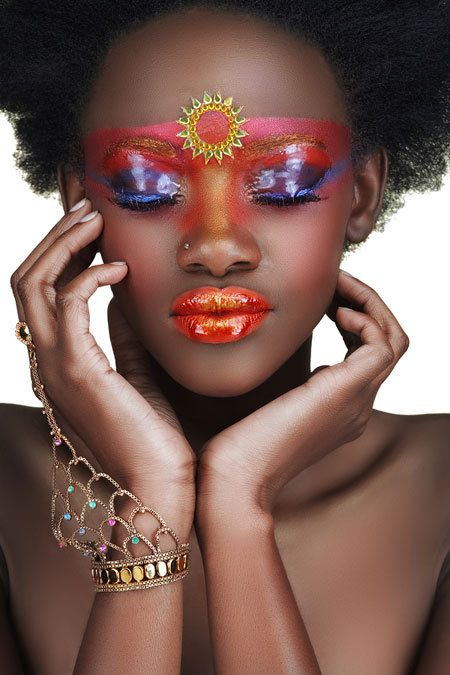 News
Articles & Recipes
Articles
Tribal Skin
News
Articles & Recipes
Articles
Tribal Skin
Tribal Skin

Not so fashion forward, designers are drawing on these ancient decorations for inspiration; where historically embellishing the skin and body with nature's bounty is associated with important matters of protection, rite of passage and mateship (not merely this season's latest look!). For thousands of years tribal peoples from around the globe have created elaborate designs, outlandish accessories, and colourful make-up inspired by the wild and bucolic landscapes enveloping them. Brilliant reds, yellows and greens, reflecting exotic flowers and lush vegetation, earthy browns and oranges representing the warm hues of the desert and burning sunsets.
Historically body painting has been used for many important reasons, many associated with survival; from making tribal warriors look intimidating in warfare, as a tool of camuflouage, for ceremonial purposes (including puberty or marriage) and to illustrate important tribal member such as chiefs, witch doctors and social castes as in India. Indigenous Australians have employed body paint for ceremonial purposes and to protecting their skin against the harsh rays of the sun and yes for the sartorial too, fashion has also played a part in body painting, even amongst the most ancient of tribes.
Using basic natural materials, indigenous peoples around the globe have relied on the vibrancy and staying power of plant extracts and earth minerals for millennium. This fool hardy decorative make-up from the earth has withstood the test of time, and the demands of tribal life; hunting, ceremonies and the like. The types of pigments used have varied from region to region.
In India, The Middle East and Africa, clay body paints were among the most common as was henna, a reddish brown pigment from the tropical shrub Lawsonia Inermis. In South America indigenous tribes employed the dark pigment of charcoal, and annatto, an orange dye from fruit seeds taken from the tree Bixa Orellana to adorn their faces and bodies. Clays, rich in minerals, have been used extensively by most cultures over time, for their incredible skin healing and skin protective benefits. Clays come in a range of colours naturally, and can be mixed with plant extracts and iron oxides from the earth to create an intense and beautiful array of colours. Many tribal cultures still employ the benefits of these ingredients today. What natural materials were used also reflected what ingredients were locally available and seasonal too.
Besides the ‘wow' factor of the tribal aesthetic it is the yearning for greener and cleaner products that are good for people and the environment that may be behind the new tribal trend – as people are going back to basics. The latest craze in make-up is not only tribal in aesthetic but also in nature. Mineral make-up, made up of zinc oxide and titanium dioxide, minerals as old as the earth itself is taking the cosmetic world by storm, with the big beauty houses around the world releasing their own mineral make-up ranges. Eddy Goncalves, Make-up director of New Directions Australia says, "there is nothing new about mineral make-up; people have been painting their bodies with earth minerals and colours since ancient times". The irony, he says is that this raw, time-honored make-up has outstanding properties – that no modern, cutting edge chemist has managed to replicate. Unlike conventional make-up the minerals when applied to the complexion with a brush allow the skin to breathe and the coverage gives an airbrushed appearance that is long-lasting.
"It is also free of chemicals unlike the bulk of cosmetic brands on the market, says Eddie. People are looking for healthier, greener solutions that work and this is it". Mineral make-up it appears is the make-up that keeps on giving. It also reduces the appearance of imperfections, such as lines and wrinkles, can be used on those with acne, sensitive skin and suitable for all ages. Eddie adds, "The minerals in mineral make-up have the added benefit of acting as a natural sun block".
To create gorgeous vibrant colours, the minerals are mixed with iron oxides, again from the earth, to create finished products including eye shadows and lipsticks that are superb. To apply mineral foundation, use a brush, or if it's the free styling tribal aesthetic you desire, give your young child a brush and ask him/her to do it for you!
Carla Oates
29 Jan 2010
